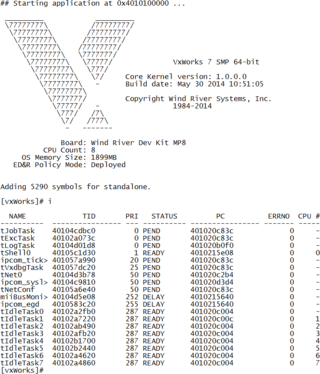
A Java virtual machine (JVM) is a virtual machine that enables a computer to run Java programs as well as programs written in other languages that are also compiled to Java bytecode. The JVM is detailed by a specification that formally describes what is required in a JVM implementation. Having a specification ensures interoperability of Java programs across different implementations so that program authors using the Java Development Kit (JDK) need not worry about idiosyncrasies of the underlying hardware platform.

An embedded system is a computer system—a combination of a computer processor, computer memory, and input/output peripheral devices—that has a dedicated function within a larger mechanical or electronic system. It is embedded as part of a complete device often including electrical or electronic hardware and mechanical parts. Because an embedded system typically controls physical operations of the machine that it is embedded within, it often has real-time computing constraints. Embedded systems control many devices in common use. In 2009, it was estimated that ninety-eight percent of all microprocessors manufactured were used in embedded systems.
SuperH is a 32-bit reduced instruction set computing (RISC) instruction set architecture (ISA) developed by Hitachi and currently produced by Renesas. It is implemented by microcontrollers and microprocessors for embedded systems.

VxWorks is a real-time operating system developed as proprietary software by Wind River Systems, a subsidiary of Aptiv. First released in 1987, VxWorks is designed for use in embedded systems requiring real-time, deterministic performance and, in many cases, safety and security certification for industries such as aerospace, defense, medical devices, industrial equipment, robotics, energy, transportation, network infrastructure, automotive, and consumer electronics.

XNU is the computer operating system (OS) kernel developed at Apple Inc. since December 1996 for use in the Mac OS X operating system and released as free and open-source software as part of the Darwin OS, which in addition to macOS is also the basis for the Apple TV Software, iOS, iPadOS, watchOS, visionOS, and tvOS OSes.
Nucleus RTOS is a real-time operating system (RTOS) produced by the Embedded Software Division of Mentor Graphics, a Siemens Business, supporting 32- and 64-bit embedded system platforms. The operating system (OS) is designed for real-time embedded systems for medical, industrial, consumer, aerospace, and Internet of things (IoT) uses. Nucleus was released first in 1993. The latest version is 3.x, and includes features such as power management, process model, 64-bit support, safety certification, and support for heterogeneous computing multi-core system on a chip (SOCs) processors.

The Blackfin is a family of 16-/32-bit microprocessors developed, manufactured and marketed by Analog Devices. The processors have built-in, fixed-point digital signal processor (DSP) functionality performed by 16-bit multiply–accumulates (MACs), accompanied on-chip by a microcontroller. It was designed for a unified low-power processor architecture that can run operating systems while simultaneously handling complex numeric tasks such as real-time H.264 video encoding.

The RapidIO architecture is a high-performance packet-switched electrical connection technology. It supports messaging, read/write and cache coherency semantics. Based on industry-standard electrical specifications such as those for Ethernet, RapidIO can be used as a chip-to-chip, board-to-board, and chassis-to-chassis interconnect.
In computer programming, a runtime system or runtime environment is a sub-system that exists both in the computer where a program is created, as well as in the computers where the program is intended to be run. The name comes from the compile time and runtime division from compiled languages, which similarly distinguishes the computer processes involved in the creation of a program (compilation) and its execution in the target machine.

FreeRTOS is a real-time operating system kernel for embedded devices that has been ported to 35 microcontroller platforms. It is distributed under the MIT License.
Eclipse ThreadX is a highly deterministic, embedded real-time operating system (RTOS) programmed mostly in the language C.
TI-RTOS is an embedded tools ecosystem created and offered by Texas Instruments (TI) for use across a range of their embedded system processors. It includes a real-time operating system (RTOS) component named TI-RTOS Kernel, networking connectivity stacks, power management, file systems, instrumentation, and inter-processor communications like DSP/BIOS Link. It is free and open-source software, released under a BSD license.
Dalvik is a discontinued process virtual machine (VM) in the Android operating system that executes applications written for Android. Dalvik was an integral part of the Android software stack in the Android versions 4.4 "KitKat" and earlier, which were commonly used on mobile devices such as mobile phones and tablet computers, and more in some devices such as smart TVs and wearables. Dalvik is open-source software, originally written by Dan Bornstein, who named it after the fishing village of Dalvík in Eyjafjörður, Iceland.
The Multicore Association was founded in 2005. Multicore Association is a member-funded, non-profit, industry consortium focused on the creation of open standard APIs, specifications, and guidelines that allow system developers and programmers to more readily adopt multicore technology into their applications.
Nano-RK is a wireless sensor networking real-time operating system (RTOS) from Carnegie Mellon University, designed to run on microcontrollers for use in sensor networks. Nano-RK supports a fixed-priority fully preemptive scheduler with fine-grained timing primitives to support real-time task sets. "Nano" implies that the RTOS is small, using 2 KB of random-access memory (RAM) and using 18 KB of flash memory, while RK is short for resource kernel. A resource kernel provides reservations on how often system resources can be used. For example, a task might only be allowed to execute 10 ms every 150 ms, or a node might only be allowed to transmit 10 network packets per minute. These reservations form a virtual energy budget to ensure a node meets its designed battery lifetime and to prevent a failed node from generating excessive network traffic. Nano-RK is open-source software, is written in C and runs on the Atmel-based FireFly sensor networking platform, the MicaZ motes, and the MSP430 processor.
CubeSat Space Protocol (CSP) is a small network-layer delivery protocol designed for CubeSats. The idea was developed by a group of students from Aalborg University in 2008, and further developed for the AAUSAT3 CubeSat mission that was launched in 2013. The protocol is based on a 32-bit header containing both network and transport layer information. Its implementation is designed for embedded systems such as the 8-bit AVR microprocessor and the 32-bit ARM and AVR from Atmel. The implementation is written in C and is ported to run on FreeRTOS and POSIX and pthreads-based operating systems such as Linux. The three-letter acronym CSP was adopted as an abbreviation for CAN Space Protocol because the first MAC-layer driver was written for CAN-bus. The physical layer has since been extended to include several other technologies, and the name was therefore extended to the more general CubeSat Space Protocol without changing the abbreviation.
DDC-I, Inc. is a privately held company providing software development of real-time operating systems, software development tools, and software services for safety-critical embedded applications, headquartered in Phoenix, Arizona. It was first created in 1985 as the Danish firm DDC International A/S, a commercial outgrowth of Dansk Datamatik Center, a Danish software research and development organization of the 1980s. The American subsidiary was created in 1986. For many years, the firm specialized in language compilers for the programming language Ada.
OpenTag is a DASH7 protocol stack and minimal Real-Time Operating System (RTOS), written in the C programming language. It is designed to run on microcontrollers or radio Systems on a Chip (SoC). OpenTag was engineered to be a very compact software package. However, with proper configuration, it can also run in any POSIX environment. OpenTag can also provide all functionality required for any type of DASH7 Mode 2 device, rather than just the eponymous “tag”-type endpoint device.

Zephyr is a small real-time operating system (RTOS) for connected, resource-constrained and embedded devices supporting multiple architectures and released under the Apache License 2.0. Zephyr includes a kernel, and all components and libraries, device drivers, protocol stacks, file systems, and firmware updates, needed to develop full application software.








